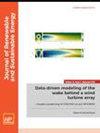Influence of incoming turbulence and shear on the flow field and performance of a lab-scale roof-mounted vertical axis wind turbine
IF 1.9
4区 工程技术
Q4 ENERGY & FUELS
引用次数: 0
Abstract
Flow conditions in an urban environment are complex, featuring varying levels of turbulence intensity and shear. The influence of these flow characteristics on the performance of a roof-mounted vertical axis wind turbine of the Savonius (drag) type is investigated at lab scale. Five different inflow conditions are generated with an active grid in a wind tunnel, covering turbulence intensities from 0.9% to 11.5% and relative vertical shear from 0% to 17%. The flow field is captured using particle image velocimetry, and the power output of the turbine is assessed through measurements of the converted power. The set-up consists of two-surface mounted cubes aligned with each other in the main flow direction, spaced apart by two cube heights. The turbine is placed on top of these model buildings at six different streamwise positions along the centerline and at two different heights. It was observed that the turbulence intensity in the inflow has a significant impact on the flow field and also on the power output of the turbine. The increasing turbulence intensity leads to smaller regions of recirculating flow. Thus, the turbine experiences higher flow velocities, which is reflected in the measured power. The influence of shear is comparably small on both the flow field and the turbine performance. The higher of the two turbine positions yields higher power output overall. Furthermore, it was shown that the impact of the turbine on the flow field is significant for all inflow conditions and can vary substantially depending on the inflow.来流湍流和剪切对实验室规模屋顶垂直轴风力机流场和性能的影响
城市环境中的流动条件是复杂的,具有不同程度的湍流强度和剪切。在实验室规模上研究了这些流动特性对萨沃纽斯(Savonius)型屋顶垂直轴风力机性能的影响。在风洞活动网格下,产生了5种不同的入流条件,湍流强度范围为0.9% ~ 11.5%,相对垂直切变范围为0% ~ 17%。利用粒子图像测速法捕获流场,并通过测量转换功率来评估涡轮机的输出功率。该装置由两个表面安装的立方体组成,在主要流动方向上彼此对齐,间隔两个立方体高度。涡轮机被放置在这些模型建筑物的顶部,沿着中心线在六个不同的流向位置和两个不同的高度。观察到来流湍流强度对流场和涡轮输出功率有显著影响。湍流强度的增加导致再循环流动区域变小。因此,涡轮经历了更高的流速,这反映在测量的功率上。剪切对流场和涡轮性能的影响都比较小。两个涡轮机位置越高,总体输出功率越高。此外,研究表明,涡轮对流场的影响在所有流入条件下都是显著的,并且可以根据流入的不同而发生很大的变化。
本文章由计算机程序翻译,如有差异,请以英文原文为准。
求助全文
约1分钟内获得全文
求助全文
来源期刊

Journal of Renewable and Sustainable Energy
ENERGY & FUELS-ENERGY & FUELS
CiteScore
4.30
自引率
12.00%
发文量
122
审稿时长
4.2 months
期刊介绍:
The Journal of Renewable and Sustainable Energy (JRSE) is an interdisciplinary, peer-reviewed journal covering all areas of renewable and sustainable energy relevant to the physical science and engineering communities. The interdisciplinary approach of the publication ensures that the editors draw from researchers worldwide in a diverse range of fields.
Topics covered include:
Renewable energy economics and policy
Renewable energy resource assessment
Solar energy: photovoltaics, solar thermal energy, solar energy for fuels
Wind energy: wind farms, rotors and blades, on- and offshore wind conditions, aerodynamics, fluid dynamics
Bioenergy: biofuels, biomass conversion, artificial photosynthesis
Distributed energy generation: rooftop PV, distributed fuel cells, distributed wind, micro-hydrogen power generation
Power distribution & systems modeling: power electronics and controls, smart grid
Energy efficient buildings: smart windows, PV, wind, power management
Energy conversion: flexoelectric, piezoelectric, thermoelectric, other technologies
Energy storage: batteries, supercapacitors, hydrogen storage, other fuels
Fuel cells: proton exchange membrane cells, solid oxide cells, hybrid fuel cells, other
Marine and hydroelectric energy: dams, tides, waves, other
Transportation: alternative vehicle technologies, plug-in technologies, other
Geothermal energy
 求助内容:
求助内容: 应助结果提醒方式:
应助结果提醒方式:


